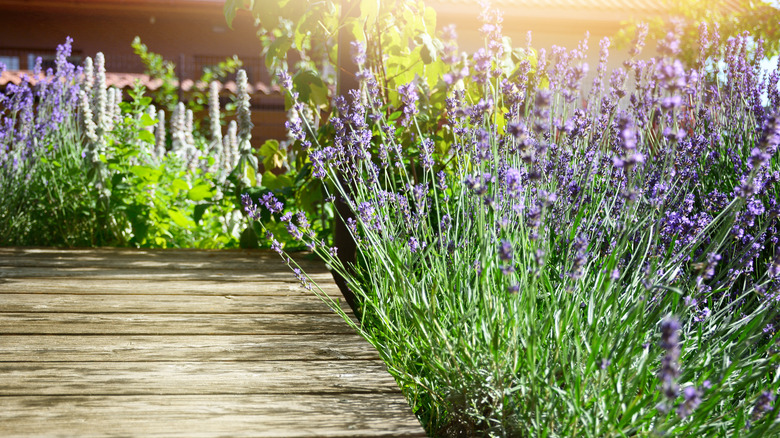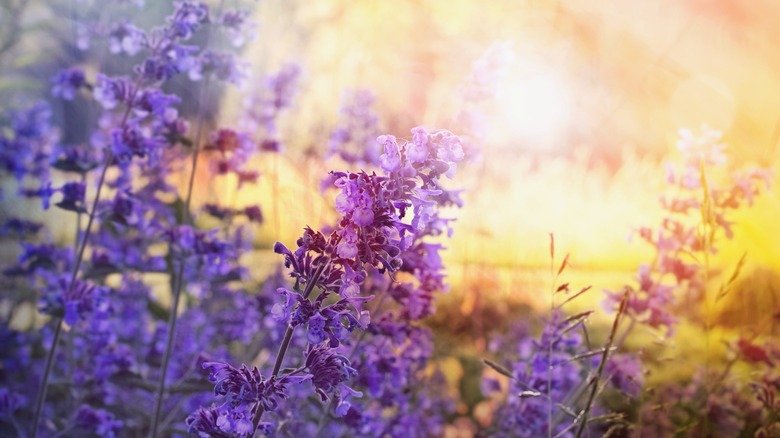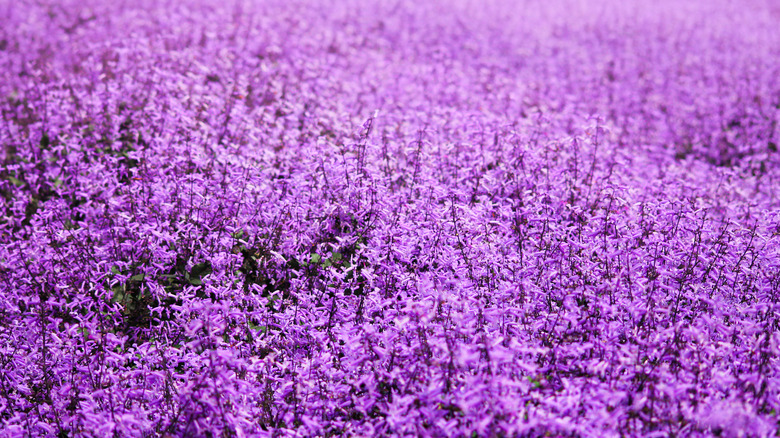The Fragrant Lavender Look-Alike That Can Withstand Harsher Conditions
Lavender is a highly prized plant — to many, its majestic purple blooms, one-of-a-kind aroma, and calming properties have no match. But unless you live in the Mediterranean climate zone of the U.S. West Coast, chances are that these beauties will not be perfectly happy in your yard, and keeping them alive will require lots of work. That's because lavender is notoriously picky about its surroundings — the temperatures, lighting, moisture, and soil conditions have to be just right for this plant to thrive. But the good news is that there are several stunning lavender alternatives that tolerate more diverse growing conditions, and catmint (Nepeta) is one of the hardiest lavender look-alikes.
Catmint is actually a relative of lavender, as both plants belong to the Lamiaceae family. Perhaps this familial proximity explains the similar appearance of these plants, as catmint varieties have the same, delicate, purple-blue flowers perched in clusters around the stem. That said, where lavender won't grow north of USDA zone 5, needs irrigation during dry spells, and can't outcompete weeds, catmint is a drought-tolerant plant that grows as far north as zone 3 and actually suppresses weeds. Here's how to choose the best Nepeta variety for your yard, and how to care for catmint plants properly.
Picking a catmint variety
First things first, decide which catmint variety you wish to plant in your yard. You'll likely have at least five or six options from which to choose. Faassen's catmint (Nepeta X faassenii) is by far the most common lavender look-alike, and it has several attractive cultivars. For example, the Walker's Low cultivar features 2-to-3-feet tall, slender, stems with purple-blue blooms that resemble lavender's at a glance. Meanwhile, the Blue Wonder cultivar is a bit shorter, with a maximum height of a foot and a half, and flowers that range in color between blue and purple. Then there's the Six Hills Giant — a catmint cultivar that lives up to its name and grows up to 3 feet tall and spreads to 4 feet. It also has the distinct, lavender-blue flowers clustered on its stems. If you're willing to experiment with color, consider planting the White Wonder or Snowflake cultivars for a splash of white, or Dawn to Dusk for a touch of pink instead of the characteristic lavender-blue.
There are a few other varieties to consider apart from Faassen's catmint. For example, Japanese catmint (Nepeta subsessilis) and Siberian catmint (Nepeta sibirica) have flatter, broader foliage and noticeably larger blooms than Nepeta X faassenii. These varieties tolerate largely the same conditions as Faassen's catmint and thrive in zones 4a to 9b, although Japanese catmint prefers more moisture in its soil.
How to grow and care for catmint
Before you plant catmint, consider whether the spot will give it enough room to spread — these perennials tend to grow sideways more than in height. A location with full sun is best, although afternoon shade is perfectly acceptable, too. It's important that the soil drains properly and isn't too nutrient-rich — excessive nutrients in the substrate will cause the plant to sprout too tall and the stems to fall over. You can plant seedling any time during the growing season. Before setting the plants in the soil, make sure the substrate is loose to the depth of roughly a foot. For each plant, create a hole that will accommodate the root ball — the latter should sit flush with the soil surface. Fill the rest of the hole gently before planting the next seedling. Spacing matters — taller cultivars should be planted about 30 inches apart, whereas shorter varieties will be happy with 2 feet of space.
Once in the ground, water the catmint often enough to help the plants get established. As the plants mature, they no longer need regular watering, and rainfall alone should suffice. After the first blooms are gone, prune the plants back — this will encourage a second bloom for the season. If you want the catmint to continue growing well, divide their clumps every three years or so in the spring.


